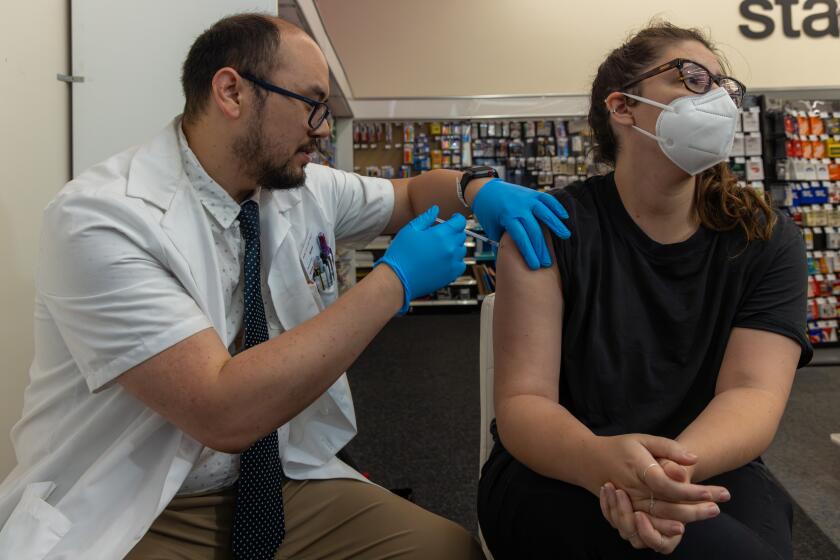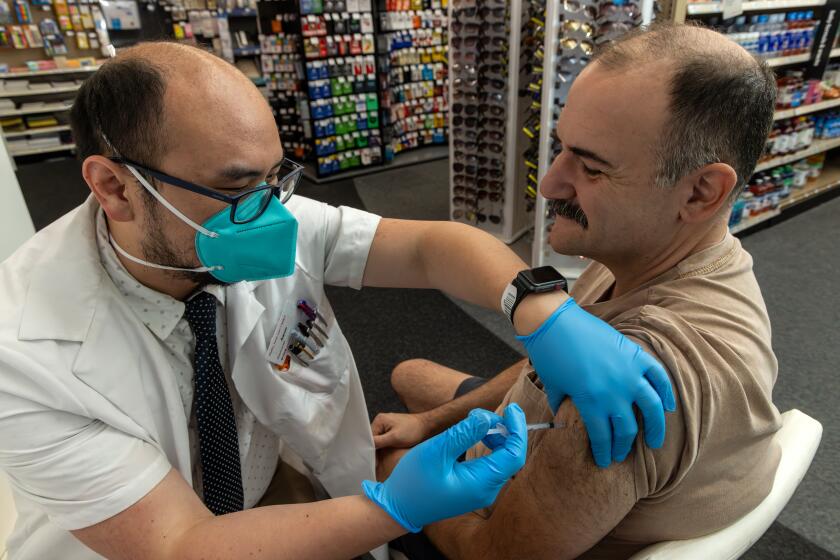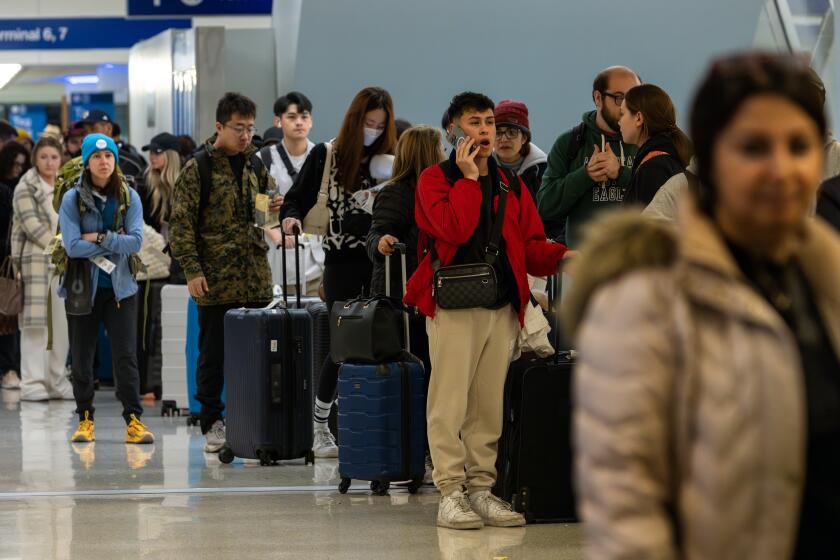One-two punch of COVID and flu is hitting L.A. County hard

- Share via
Coronavirus levels are high and rising throughout California amid a post-holiday spike in infections.
The uptick, documented through wastewater surveillance, is coinciding with a sharp rise in flu activity — a one-two punch for what’s proving to be a busy respiratory virus season.
“We are certainly in some high levels of viral transmission. Flu is one of the bigger drivers of that right now,” state epidemiologist Dr. Erica Pan said in a recent briefing. “We are seeing some increases in COVID-19 activity, especially often after the travel and gatherings of the holiday season.”
New data show pronounced recent jumps in the rate at which coronavirus and flu tests are coming back positive, as well as the number of hospital-admitted patients testing positive for the viruses.
Around Christmas, flu was responsible for 4% of weekly emergency room visits statewide, up from about 1% a month earlier. COVID-19 was responsible for about 2%, up from about 1%.
For the week that ended Dec. 30 in Los Angeles County, the wastewater concentration of SARS-CoV-2 — the virus that causes COVID-19 — reached 60% of last winter’s peak, up from the prior week’s reading of 49%.
Statewide, the rates at which tests for COVID-19 and flu are coming back positive continue to rise. California continues to show “very high” flu-like activity, which includes non-flu illnesses such as COVID-19, according to the U.S. Centers for Disease Control and Prevention.
While COVID-19 is no longer exerting the dangerous and devastating pressure seen earlier in the pandemic, it has not been defanged. Officials from the World Health Organization noted that 10,000 deaths were reported globally from COVID-19 in December, based on data from fewer than 50 countries, mostly in the Americas and Europe.
“Although 10,000 deaths a month is far less than the peak of the pandemic, this level of preventable death is not acceptable,” Tedros Adhanom Ghebreyesus, director-general of the WHO, said at a recent briefing. “We continue to call on individuals to be vaccinated, to test, to wear masks where needed and to ensure crowded indoor spaces are well ventilated.”
The World Health Organization says holiday gatherings and the reigning coronavirus variant globally led to increased infections and deaths last month.
The CDC reported more than 6,000 COVID-19 deaths nationally in December, a toll that is expected to rise.
Health officials noted that many deaths could have been avoided with higher rates of vaccination.
“The vaccines may not stop you being infected, but the vaccines are certainly reducing significantly your chance of being hospitalized or dying,” Dr. Michael Ryan, executive director of the WHO’s health emergencies program, said at the briefing. “And it really means that those people in vulnerable age groups with underlying conditions ... taking the opportunity to be vaccinated against SARS-CoV-2 and against influenza is the best investment you can make.”
Uptake in COVID and flu vaccinations has been lackluster. Statewide, 31% of residents age 65 and older have received the updated COVID-19 vaccination since September, Pan said.
At nursing homes in California that report such data, 33% of residents and 10% of staff have received the updated COVID-19 vaccines — well below typical uptake of the flu shot, which is about 50%.
“This is where we see outbreaks. This is where we have the most deaths and, certainly, the most hospitalizations,” Pan said.
The delay in accurate test results is probably a result of people having accumulated immunity from COVID-19 over the years, whether from vaccinations or previous infections.
California is doing worse than other states in terms of getting residents of nursing homes vaccinated against not only COVID-19, but flu and respiratory syncytial virus, or RSV, Pan said.
However, health officials are closely watching to see whether there are early indications that the winter respiratory viral season may be plateauing.
In California, there were 3,716 new coronavirus-positive hospitalizations for the week to Jan. 6, versus the prior week’s 3,720, which was the highest tally this winter, according to CDC data.
By contrast, last winter peaked at 5,260 coronavirus-positive hospitalizations for the week that ended Dec. 31, 2022. That was well shy of the heights seen during the devastating first two winters of the pandemic, when weekly hospital admissions topped out at more than 14,600.
The new flu and COVID vaccines are specifically formulated to protect against particular viral strains that officials feel will be prevalent this fall and winter.
Nationwide, coronavirus-positive hospitalizations are still rising. There were 35,801 for the week that ended Jan. 6, up 3% from the prior week. Last winter’s peak was 44,545, during the final week of 2022.
It’s noteworthy that while national wastewater data suggest that this winter may be spawning the most coronavirus infections in any given week since the first Omicron wave in the winter of 2021-22, hospitalizations have remained lower than in any winter of the COVID-19 era.
“Is this ... that we’re actually seeing more mild infection in people that are not getting tested, or reporting tests or seeking healthcare? Or are there are other reasons — is there more shedding of the currently circulating variants?” Pan said.
Hospitalizations remain elevated in L.A. County, public health officials say. But on Friday, the county moved out of the “medium” COVID-19 hospitalization level and back into “low,” according to the CDC. Orange County is still at medium.
The waning impact of COVID-19 has prompted public health officials for both California and L.A. County to relax guidance on isolation time after infection.
COVID-19, flu and respiratory syncytial virus (RSV) cases are all on the rise or at a high level in California and elsewhere.
“Previous isolation recommendations were implemented to reduce the spread of a virus to which the population had little immunity and had led to large numbers of hospitalizations and deaths that overwhelmed our healthcare systems during the pandemic,” the California Department of Public Health said in a statement Tuesday. “We are now at a different point in time with reduced impacts from COVID-19 compared to prior years, due to broad immunity from vaccination and/or natural infection and readily available treatments for infected people.”
State and L.A. County officials say those who test positive need to isolate and stay home only while they have symptoms; they can end isolation once their symptoms are mild and improving and when they haven’t had a fever for 24 hours without using medication. Those who test positive yet are asymptomatic need not stay home, according to the guidance.
Previous guidance stated that those infected should stay home for at least five days.
California’s hospitals are getting busier with more COVID-19 and flu patients. Los Angeles County recently entering the ‘medium’ COVID-19 category for the first time this winter.
Anyone with COVID-19 need to wear a mask around others for 10 days after the beginning of symptoms or, if asymptomatic, after first testing positive. Infected people can stop masking sooner if they test negative on two consecutive rapid tests taken at least one day apart.
Still, anyone who has COVID-19 should stay away from people at higher risk for severe illness for 10 days, officials say. They should speak with a healthcare provider as soon as possible to learn whether they may be eligible for treatment, such as a prescription for Paxlovid or other antiviral medication.
The CDC, which most recently updated its guidance last spring, still recommends isolating for at least five days following the onset of symptoms or your first positive test if you have no symptoms.
More to Read
Sign up for Essential California
The most important California stories and recommendations in your inbox every morning.
You may occasionally receive promotional content from the Los Angeles Times.

















